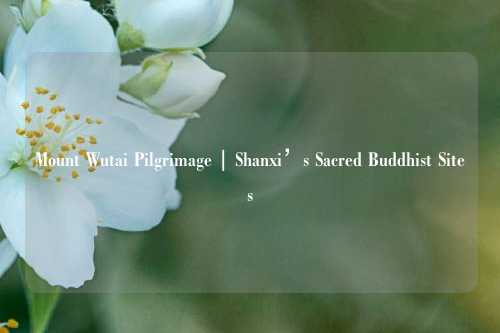Mount Wutai Pilgrimage | Shanxi’s Sacred Buddhist Sites
A Journey to Mount Wutai: Shanxi’s Sacred Buddhist Destination
Mount Wutai, located in Shanxi Province, is one of the most important and revered mountains in Chinese Buddhism. Known as one of the Four Sacred Buddhist Mountains of China, Mount Wutai has attracted pilgrims, scholars, and tourists for centuries due to its deep religious significance, stunning landscapes, and historical importance. This majestic mountain, with its unique architecture, spiritual atmosphere, and scenic beauty, offers an enriching experience for those who embark on its pilgrimage routes or simply wish to explore its ancient temples and cultural heritage.
The Spiritual Significance of Mount Wutai
The name "Wutai" translates to "Five Terraces," a reference to the five prominent peaks that rise dramatically from the surrounding landscape, each symbolizing a different aspect of Buddhist enlightenment. Mount Wutai is particularly sacred to Tibetan Buddhists and is believed to be the home of the Bodhisattva Manjushri, the Bodhisattva of wisdom. Throughout history, Mount Wutai has been a hub for Buddhist scholars and monks who come here to meditate, practice, and seek enlightenment.

For centuries, this sacred mountain has been a pilgrimage site, with people from all over China and beyond traveling to pay homage to Manjushri and deepen their spiritual practice. Many Buddhist temples and monasteries have been built on the mountain, creating an extensive network of religious sites that are essential to the region’s identity and cultural heritage. The spiritual ambiance of Mount Wutai provides visitors with the opportunity for quiet reflection, prayer, and contemplation amidst breathtaking natural surroundings.
A Rich Historical and Cultural Legacy
The cultural significance of Mount Wutai extends far beyond its religious role. The mountain has been an intellectual and artistic center for centuries, attracting poets, painters, and philosophers. The peak has inspired countless works of art, literature, and religious studies, creating a rich legacy of intellectual and artistic exploration. Visitors can explore ancient temples, historical monuments, and inscriptions that showcase the historical importance of Mount Wutai.
One of the most significant aspects of Mount Wutai is its deep connection to the development of Buddhism in China. It was here that many Buddhist texts were translated, and many important Buddhist doctrines were spread. Over the centuries, the mountain has witnessed the rise of various Buddhist schools and the development of unique religious practices that continue to shape Chinese Buddhism today.
The Stunning Landscape of Mount Wutai
The breathtaking natural beauty of Mount Wutai is another major attraction for visitors. The mountain, which rises over 3,000 meters (about 10,000 feet) above sea level, is known for its unique landscapes, characterized by rugged peaks, lush forests, and clear streams. The five main peaks, which are the focus of the pilgrimage, each have their own distinct features and offer visitors unparalleled views of the surrounding region.
The serene atmosphere of the mountain makes it a perfect destination for those seeking peace and tranquility. The beauty of Mount Wutai changes with the seasons, with vibrant wildflowers in the spring, lush greenery in the summer, colorful foliage in the autumn, and snow-covered peaks in the winter. The picturesque scenery provides a stunning backdrop for spiritual practice, hiking, and photography.
Pilgrimage Routes and Temples
For centuries, the pilgrimage routes to Mount Wutai have been an important part of Buddhist practice. Pilgrims travel these paths as part of their religious devotion, walking long distances to visit the mountain’s temples, monasteries, and sacred sites. The pilgrimage involves visiting several key locations on the mountain, each offering a unique spiritual experience.
The most well-known temple on Mount Wutai is the Xiantong Temple, the largest and oldest temple on the mountain. Originally built during the Tang Dynasty, the temple is a prime example of ancient Chinese Buddhist architecture. It is a popular destination for both pilgrims and tourists alike, offering a peaceful space for worship and meditation. The temple houses statues of important Buddhist figures, including Manjushri, and is home to several Buddhist monks who lead ceremonies and provide spiritual guidance to visitors.
In addition to Xiantong Temple, there are numerous other temples on Mount Wutai, including the Tayuan Temple, the Nanshan Temple, and the Guandi Temple. Each of these sites has its own unique characteristics, and visiting them allows travelers to experience the full depth of the religious and cultural heritage of the mountain.
Exploring the Peaks of Mount Wutai
The five peaks of Mount Wutai each hold a distinct spiritual meaning and are essential to the pilgrimage. Pilgrims and visitors typically travel from one peak to the next, climbing the steep mountain paths to reach the summit of each peak. Each peak is associated with different aspects of wisdom, meditation, and enlightenment.
The Eastern Peak, also known as the Taihuai Peak, is often the first peak visited on the pilgrimage route. It is believed to be the site where Manjushri first attained enlightenment, and it offers stunning views of the surrounding landscape. The Central Peak, the highest peak of Mount Wutai, is known as the "Wisdom Peak" and is the focal point of the mountain’s spiritual energy. Visitors who reach the top of the Central Peak are often treated to panoramic views of the entire mountain range.
The Northern Peak, the Western Peak, and the Southern Peak each hold their own spiritual significance, with each peak offering different experiences of solitude, beauty, and reflection. Hiking to each of these peaks is a physically demanding yet spiritually rewarding journey, allowing visitors to connect with nature and engage in deep personal reflection.
The Role of Monasteries and Buddhist Institutions
Mount Wutai is home to numerous monasteries and Buddhist institutions that have been integral to the development of Chinese Buddhism. These monasteries have served as centers of learning, meditation, and religious practice for centuries. Many of the mountain’s monks live in these monasteries, where they continue to teach Buddhist philosophy and engage in prayer and meditation.
The Wutai Mountain Buddhist Academy, located near the foot of the mountain, is one such institution. It offers a place for monks and scholars to study Buddhist texts, learn meditation practices, and deepen their understanding of Buddhist teachings. Visitors who are interested in Buddhist philosophy and meditation can visit the academy to learn more about the practices and traditions that have shaped Chinese Buddhism.
The Spiritual and Personal Experience of Visiting Mount Wutai
For many visitors, the experience of traveling to Mount Wutai is deeply personal and transformative. The mountain’s combination of sacred history, stunning landscapes, and rich cultural traditions offers a unique opportunity for self-reflection and spiritual growth. Whether you are visiting as a pilgrim, a tourist, or a scholar, Mount Wutai provides an environment where you can connect with something larger than yourself.
The experience of walking the pilgrimage routes, visiting the temples, and climbing the peaks is one of physical and spiritual discovery. The mountain offers visitors the opportunity to disconnect from the pressures of daily life and immerse themselves in the peaceful atmosphere of the mountainside. The serenity and tranquility of Mount Wutai allow individuals to engage in deep personal reflection, meditation, and prayer.
The Influence of Mount Wutai on Chinese Buddhism
Mount Wutai has had a lasting impact on the development of Chinese Buddhism. As one of the most important Buddhist centers in the country, it has influenced many of the religious practices, rituals, and philosophies that continue to shape Chinese Buddhism today. The teachings of Manjushri, who is associated with wisdom and enlightenment, are central to the spiritual practices followed by the mountain’s visitors and residents.
Over the centuries, Mount Wutai has played a central role in the spread of Buddhism throughout China. The mountain has served as a center for the study and translation of Buddhist texts, and many Buddhist scholars have traveled to Mount Wutai to study, meditate, and learn from the great Buddhist masters who have lived there.
A Destination for All Seasons
Mount Wutai is a year-round destination, offering different experiences depending on the season. In the spring, the mountain comes alive with colorful flowers and lush greenery, making it a beautiful time to visit. Summer brings warm weather and clear skies, perfect for hiking and exploring the mountain’s temples and peaks. Autumn offers a breathtaking display of foliage, while winter brings a peaceful serenity to the mountain, with snow covering the peaks and creating a quiet, contemplative atmosphere.
Whether you visit during the peak pilgrimage seasons or in the quieter months, Mount Wutai offers a deeply enriching and rewarding experience for all who come to explore its sacred grounds.
















